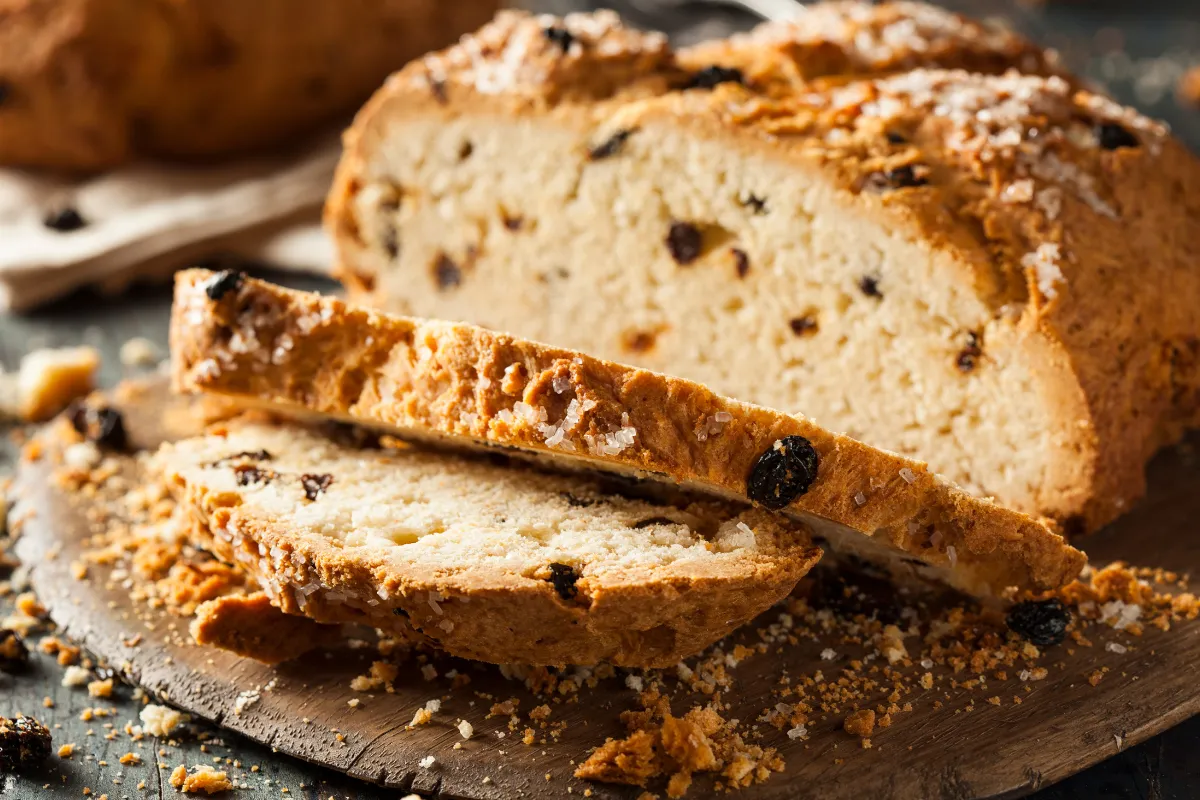Welcome to the world of Irish soda bread, where tradition meets taste in a delightful symphony of flavors and textures.
Whether you’re an experienced baker or a novice in the kitchen, crafting this classic bread is an experience that promises satisfaction with every bite.
In this article, we’ll delve into the origins of Irish soda bread, explore its key ingredients, and guide you through a step-by-step recipe that will have you savoring the authentic taste of Ireland in your own home.
Unraveling the Origins of Irish Soda Bread

Irish soda bread holds a special place in Irish culinary heritage, with its roots tracing back to the 19th century.
During this time, baking soda (bicarbonate of soda) became a popular leavening agent in Ireland, as it offered a convenient alternative to yeast, which was often scarce and expensive.
Thus, the simple yet ingenious recipe for Irish soda bread was born, featuring basic ingredients that were readily available to Irish households.
Key Ingredients That Make Irish Soda Bread Unique
The beauty of Irish soda bread lies in its simplicity, with just a handful of ingredients coming together to create a rustic loaf that’s dense yet tender.
The essential components include:
Flour
The backbone of any bread recipe, flour provides structure and texture to Irish soda bread.
Traditional recipes call for a blend of all-purpose flour and whole wheat flour, although variations with alternative flours such as spelt or oat flour are also popular.
Baking Soda
As the namesake ingredient, baking soda serves as the leavening agent in Irish soda bread, helping it rise without the need for yeast.
When combined with an acidic component like buttermilk, baking soda produces carbon dioxide gas, which aerates the dough and gives the bread its characteristic texture.
Buttermilk
Rich and tangy, buttermilk not only adds moisture to the dough but also reacts with the baking soda to create the chemical reaction that causes the bread to rise.
Its acidity contributes to the distinctive flavor profile of Irish soda bread, lending it a subtle hint of sourness.
Salt
A pinch of salt enhances the flavor of Irish soda bread, balancing out the sweetness of the flour and buttermilk.
Additionally, salt helps to strengthen the gluten network in the dough, resulting in a more cohesive and elastic texture.
Step-by-Step Recipe for Homemade Irish Soda Bread

Now that we’ve covered the fundamentals, let’s dive into the process of making Irish soda bread from scratch.
Follow these simple steps for a rewarding baking experience:
Step 1: Preparing the Dry Ingredients
- In a large mixing bowl, combine 4 cups of all-purpose flour, 1 cup of whole wheat flour, 1 teaspoon of baking soda, and 1 teaspoon of salt.
Step 2: Incorporating the Wet Ingredients
- Create a well in the center of the dry ingredients and pour in 1 and 3/4 cups of buttermilk. Using a wooden spoon or your hands, gently mix the ingredients until a shaggy dough forms.
Step 3: Kneading the Dough
- Turn the dough out onto a floured surface and knead it lightly for about 1 minute, just until it comes together into a cohesive ball. Avoid overworking the dough, as this can result in a tough loaf.
Step 4: Shaping and Scoring the Dough
Use a sharp knife to score a cross on the top of the loaf, allowing the bread to expand evenly as it bakes.
Step 5: Baking to Perfection
- Preheat your oven to 425°F (220°C) and bake the Irish soda bread for 35-40 minutes, or until it’s golden brown and sounds hollow when tapped on the bottom.
Conclusion:
Congratulations! You’ve successfully mastered the art of Irish soda bread, unlocking the secrets of this beloved Irish delicacy.
Whether enjoyed fresh out of the oven with a slather of butter or paired with your favorite soup or stew, your homemade loaf is sure to impress with its rustic charm and irresistible flavor.
So gather your ingredients, roll up your sleeves, and embark on a culinary journey that celebrates tradition, simplicity, and the joy of baking.
FAQs:
Can I substitute the buttermilk in the recipe?
A1: While buttermilk is traditional in Irish soda bread, you can make a homemade alternative by mixing 1 tablespoon of lemon juice or vinegar with 1 cup of milk.
Can I add other ingredients like raisins or seeds to the dough?
A2: Absolutely! Feel free to customize your Irish soda bread with additions like raisins, currants, caraway seeds, or even grated cheese for a unique twist on the classic recipe.
How should I store leftover Irish soda bread?
A3: To keep your bread fresh, store it in an airtight container or resealable bag at room temperature for up to 2-3 days. You can also freeze sliced bread for longer storage and simply thaw it at room temperature when ready to enjoy.
Why did my soda bread turn out dense and heavy?
A4: Overworking the dough or using too much flour can result in a dense loaf. Be sure to handle the dough gently and only knead it until it comes together. Additionally, avoid compacting the dough too tightly when shaping the loaf.
Can I make Irish soda bread gluten-free?
A5: Yes, you can experiment with gluten-free flour blends to make a suitable alternative. Keep in mind that the texture and flavor may differ slightly from tradition

